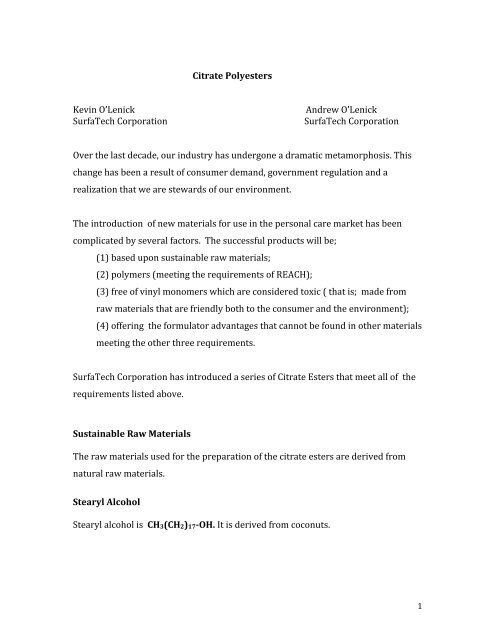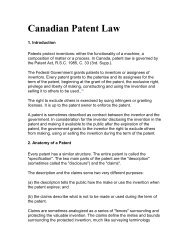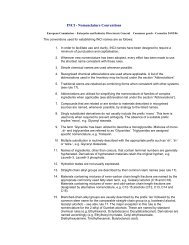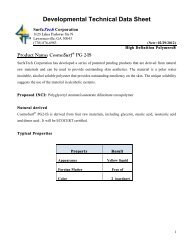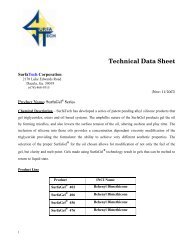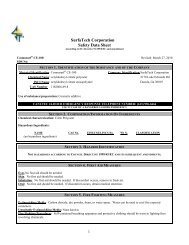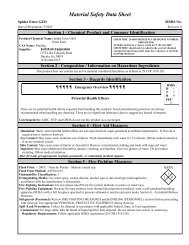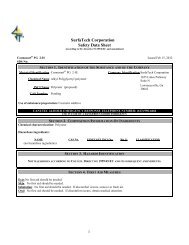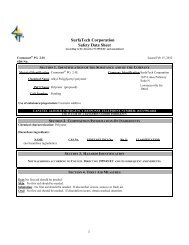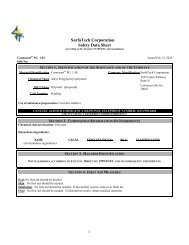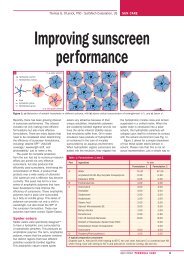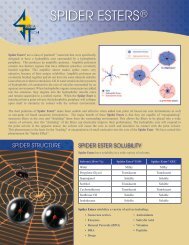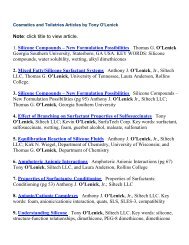1 Citrate Polyesters Kevin O'Lenick - SurfaTech
1 Citrate Polyesters Kevin O'Lenick - SurfaTech
1 Citrate Polyesters Kevin O'Lenick - SurfaTech
You also want an ePaper? Increase the reach of your titles
YUMPU automatically turns print PDFs into web optimized ePapers that Google loves.
<strong>Citrate</strong> <strong>Polyesters</strong> <br />
<strong>Kevin</strong> O’Lenick <br />
<strong>SurfaTech</strong> Corporation <br />
Andrew O’Lenick <br />
<strong>SurfaTech</strong> Corporation <br />
Over the last decade, our industry has undergone a dramatic metamorphosis. This <br />
change has been a result of consumer demand, government regulation and a <br />
realization that we are stewards of our environment. <br />
The introduction of new materials for use in the personal care market has been <br />
complicated by several factors. The successful products will be; <br />
(1) based upon sustainable raw materials; <br />
(2) polymers (meeting the requirements of REACH); <br />
(3) free of vinyl monomers which are considered toxic ( that is; made from <br />
raw materials that are friendly both to the consumer and the environment); <br />
(4) offering the formulator advantages that cannot be found in other materials <br />
meeting the other three requirements. <br />
<strong>SurfaTech</strong> Corporation has introduced a series of <strong>Citrate</strong> Esters that meet all of the <br />
requirements listed above. <br />
Sustainable Raw Materials <br />
The raw materials used for the preparation of the citrate esters are derived from <br />
natural raw materials. <br />
Stearyl Alcohol <br />
Stearyl alcohol is CH3(CH2)17-OH. It is derived from coconuts. <br />
<br />
1
Octyldodecanol <br />
Octyldodecanol is: <br />
(CH 2 ) 7 CH 3<br />
|<br />
CH 3 -(CH 2 ) 9 -CH-CH 2 -OH<br />
It is derived from coconuts. <br />
1, 3 Propanediol<br />
HO-(CH 2 ) 3- OH<br />
Zemea ® propanediol is a colorless and highly purified glycol derived from a<br />
sustainable and renewable corn sugar fermentation process. Approved by Ecocert and<br />
certified by the Natural Products Association (NPA), Zemea ® is a 100% natural<br />
ingredient. Zemea ® propanediol is the perfect glycol compound for formulations where<br />
non-petroleum based ingredients are desired. The benefits of Zemea ® propanediol include<br />
purity, lack of irritation and sensitization, and environmental sustainability<br />
Citric Acid<br />
Citric acid is: (I lined up the structure) <br />
H2C-C(O)OH <br />
| <br />
HO-C-C(O)OH <br />
| <br />
H2-C-C(O)OH <br />
Citric acid is is a product of the fermentation of glucose.<br />
<br />
2
Molecular design <br />
The first class of materials is the triester. For example Tri-octyldocecyl citrate is a<br />
known material.<br />
Molecules with no reactive carboxyl groups <br />
H2C-C(O)OR <br />
| <br />
HO-C-C(O)OR <br />
| <br />
H2C-C(O)OR <br />
Tri-substituted citrate esters<br />
R is a mixture of<br />
50% -(CH 2 ) 17 -CH 3<br />
and<br />
50% (CH 2 ) 7 CH 3<br />
|<br />
CH 3 -(CH 2 ) 9 -CH-CH 2 -<br />
<br />
3
The product is a slushy liquid.<br />
When R is:<br />
(CH 2 ) 7 CH 3<br />
|<br />
CH 3 -(CH 2 ) 9 -CH-CH 2 -<br />
This product is tri-octyldodecyl citrate 1 ; a liquid C66 ester. It is not a polymer<br />
under REACH. And since all three acid groups are esterified it cannot be incorporated<br />
into a polymer. (Although some may argue that the OH could be reacted into a polymer;<br />
but with difficulty)<br />
Polymers <br />
High Definition Polymers ® are the product of molecular modeling, allowing the<br />
chemist to focus in on every detail of the molecule in order to dial in the desired<br />
aesthetics .. Three different types of alcohols are incorporated in order to provide<br />
different properties to these products. The liquid C 20 octyldodecanol is a highly branched<br />
molecule that stays liquid and provides cushion. This material helps spread the product<br />
on the skin and while it does have cushion it leaves a very light dry feel on the skin. Use<br />
of a solid C 18 stearyl alcohol leaves a soft barrier on the skin and provides structure. This<br />
product has a melting point close to body temperature allowing it to liquefy when applied<br />
to the skin.<br />
<br />
4
Chain Terminators <br />
Chain terminators have one group that is reactive. For simplicity, we are showing<br />
the carboxyl group on the third carbon as the reactive species, but from an esterification<br />
point of view would be equally reactive on each of the three positions..<br />
H2C-C(O)OR <br />
| <br />
HO-C-C(O)OR <br />
| <br />
H2C-C(O)OH <br />
Chain Extenders <br />
Chain extenders have two groups that are reactive. For simplicity, we are showing<br />
the second and third carbon as the reactive ones, but from an esterification point of view<br />
all three are equally reactive.<br />
H2C-C(O)OR <br />
| <br />
HO-C-C(O)OH <br />
| <br />
H2C-C(O)OH <br />
Chain Branching <br />
Chain branching groups have all three groups available for reaction.<br />
H2-C-C(O)OH <br />
| <br />
HO-C-C(O)OH <br />
| <br />
H2C-C(O)OH <br />
<br />
5
Crosslinking Groups <br />
The reactive carboxyl groups are linked to each other using a 1,3 propanediol<br />
derived from corn.<br />
HO-(CH2)3-OH <br />
It is only when all of these materials are combined in the proper ratio that the<br />
desired products are obtained. The reaction forms a polyester, and includes no vinyl<br />
reactive groups. Also there are no undesirable monomers.<br />
When the components which are crosslinked are simply combined with each other<br />
as individual components in the same ratio as that used to make a polymer, the mixture is<br />
a non-uniform mixture of all components. Photomicrographs clearly show this.<br />
When reacted the same ratio of components are then crosslinked with 1,3<br />
propanediol a polymer is formed that no longer is simply a mixture, but is a condensation<br />
polymer having a very specific structure and consequently a very specific properties.<br />
The most simple representation of the polymers is one in which all the reactive<br />
positions are as shown.<br />
H2-C-C(O)OR <br />
H2C-C(O)O]x(CH2)3OC(O)-CH2 <br />
| | | <br />
HO-C-C(O)OR RO-C(O)-C-OH HO-C-C(O)OR <br />
| | | <br />
H2C-C(O)O[(CH2)3-O-C(O)-CH2 <br />
H2C-C(O)OR <br />
Chain Terminator (Chain Extender)x Chain Terminator <br />
<br />
6
Photomicrographs <br />
The photomicrographs and conclusions provided in this section were provided by<br />
Microtrace LLC<br />
790 Fletcher Drive<br />
Suite 106<br />
Elgin, IL 60123-4755<br />
•The following samples were submitted for photomicrographic evaluation:<br />
•1. Non-crosslinked - citrate ester with no crosslinking having<br />
50% by weight C 18 (stearyl) and<br />
50% C 20 branched (octyldodecanol).<br />
and<br />
•2. Crosslinked citrate ester having<br />
50% by weight C 18 (stearyl) and 50%<br />
C 20 branched (octyldodecanol), crosslinked<br />
with 1,3 propane diol.<br />
Non-crosslinked Photomicrographs<br />
All four components are clearly seen. The large crystals (laths and blocky<br />
crystals) melt between approximately 39°C and 42°C. The fine acicular crystals begin to<br />
melt at approximately 44°C and all of these crystals have melted by 55.8°C with most<br />
having melted by 50°C. The black areas are the liquid phase.<br />
<br />
7
Photomicrograph A <br />
•The non-crosslinked material is a viscous liquid containing three types of anisotropic<br />
crystals suspended in an isotropic liquid phase. The crystals have a bimodal particle size<br />
distribution.<br />
•The large blocky crystals melt over the range of 39° - 42.2°C<br />
•The small needle-like crystals melt over the range of 44° - 55.8°C. Melting is<br />
appreciably complete by ~50°C with only a few crystals melting at 55.8°C. The crystals<br />
disappear into the liquid phase as they melt.<br />
•The onset of melting is approximate since it is difficult to see individual crystals melting<br />
when there are many of them in the field.<br />
<br />
8
Polymer <br />
The introduction of crosslinking makes the product a polymer, rather than a<br />
collection of non-polymeric materials.<br />
The product consists of uniformly sized acicular to narrow lath shaped crystals.<br />
Melting of the crystals occurs over a wide temperature range. The onset of melting is<br />
difficult to recognize (approximately 42°C) and approximately one half of the crystals<br />
have melted by 45°C. The last of the crystals melts by 48.4°C. Black regions are the<br />
liquid crystal phase.<br />
Photomicrograph B <br />
•The crosslinked product is a thick paste consisting of a single anisotropic crystalline<br />
phase.<br />
•The crystalline phase melts over the range of ~ 42°C to 48.4°C. By ~ 45°C most of the<br />
crystals have melted and disappeared into the liquid phase.<br />
•The crystals exhibit a narrow particle size distribution and are significantly smaller in<br />
size than the large crystals (lower melting phase) in the non-crosslinked product.<br />
<br />
9
Commercial Crosslinked Polymer Products <br />
Product INCI Description<br />
CosmoSurf ® CE-‐100 octyldodecyl citrate Liquid lower viscosity <br />
Crosspolymer <br />
(ECOCERT Approved) <br />
CosmoSurf ® CE-‐100HV octyldodecyl citrate <br />
crosspolymer <br />
High molecular weight liquid <br />
(ECOCERT pending) <br />
CosmoSurf ® CE-‐140 octyldodecyl stearyl citrate Soft wax <br />
crosspolymer <br />
(ECOCERT pending) <br />
CosmoSurf ® CE-‐150 octyldodecyl stearyl citrate Medium hardness wax <br />
crosspolymer <br />
(ECOCERT pending) <br />
CosmoSurf ® CE-‐250 octyldodecyl behenyl citrate Hard Wax <br />
crosspolymer <br />
(ECOCERT pending) <br />
<br />
10
Water Proofing Study <br />
Lott Research, Inc undertook a study to determine if Cosmosurf CE-150<br />
(<strong>SurfaTech</strong> Corporation) could be used as a waterproofing film former for sunscreen<br />
products. <br />
Method <br />
Formulas were prepared as shown: <br />
Ingredient <br />
LRI A80 <br />
% <br />
LRI 220 <br />
% <br />
LRI A175 <br />
% <br />
Part A <br />
Water 74.2 72.2 82.9 <br />
Carbomer .25 .25 .25 <br />
Disodium Ethylenediaminetetraacetic .05 .05 .05 <br />
Acid <br />
Triethanolamine 1 1 1 <br />
Part B <br />
Octocrylene 3 3 3 <br />
Octisalate 3 3 3 <br />
Oxybenzone 2 2 2 <br />
Avobenzone 1 1 1 <br />
Stearic Acid 2 1 1 <br />
Sorbitan Isostearate 0 1 1 <br />
Polyglyceryl-3 Distearate 0 1 1 <br />
Glyceryl Stearate Self Emulsifying 3 0 0 <br />
Benzyl Alcohol 1 1 1 <br />
Dimethylpolysiloxane .5 .5 .5 <br />
VP/Eicosene Copolymer 0 0 2 <br />
Methylparaben 0 .2 .2 <br />
Propylparaben 0 .1 .1 <br />
Finsolv TN 8 0 0 <br />
Cosmosurf CE-100 0 2 0 <br />
Part C <br />
Liquipar PE(Phenoxyethanol, <br />
Isopropylparaben, Isobutylparaben, <br />
and n-Butylparaben <br />
1 0 0 <br />
The manufacturing procedure was basically the same for all three products; Part A<br />
and B were heated separately to about 160(put in degree signs)F, B added to A while<br />
<br />
11
apidly stirring, cooled with stirring to approximately 105 F and Part C was added with<br />
stirring.<br />
All three formulas were SPF tested using a single port Solar Light Model 15S<br />
Xenon Arc, Solar Simulator lamp, which has a continuous light spectrum in the UVA and<br />
UVB range (290-400 nanometers). The spectral output of the solar simulator is filtered<br />
so that it meets the spectral output requirements for testing Sunscreen Drug Products for<br />
over-the-counter human use; Proposed Amendment of Final Monograph, CFR Part<br />
352.70 (b) Light Sources, Federal Register, Vol. 72, No. 165, Aug. 27, 2007 and the<br />
International Sun Protection Factor (SPF) Test Method, May 2006.<br />
The SPF test for all three formulas was performed on the same subjects. The only<br />
difference was that LRIA80 was performed as a static, non water resistant test and LRI<br />
A220 and LRI A175 were performed as an 80 minutes VWR test.<br />
All three formulations were submitted to an independent analytical lab, Allied<br />
Analytical Laboratory Services. <br />
Results <br />
The average values for the SPF tests as reported by Florida Suncare Testing, Inc. <br />
were as follows: <br />
LRI A80 < 19(static) No waterproofing Agent <br />
LRI 220 28.85(VWR) VP/Eicosene Copolymer <br />
LRI A175 29.05(VWR) Cosmosurf CE-‐150 <br />
The analytical results for the formulations are shown below in % by weight. <br />
Octocrylene Octisalate Oxybenzone Avobenzone <br />
LRI A80 3.03 3.12 2.02 1.04 <br />
LRI A220 2.94 3.04 1.95 0.95 <br />
LRI A175 3.04 2.96 1.99 1.00 <br />
<br />
12
Discussion <br />
All three formulas were targeted as an SPF 25. For an SPF 25 the lowest number<br />
obtainable is a SPF19. Four of the subjects had MED responses at the SPF 19 level.<br />
When this happens it means the actual value is at a maximum SPF 19. Based on<br />
discussions with the Florida Suncare Testing, Inc. investigator the values would probably<br />
have been considerably lower than 19. The investigator estimated that the actual value<br />
would probably have been closer to SPF 12- 15 based on the responses at SPF 19. For a<br />
5 subject study, the values obtained for LRI A220 and LRI A175, with standard<br />
deviations of 2.53 and 4.12 respectively are not statistically different.<br />
Conclusion <br />
Based on the results of these SPF tests has significant value as a SPF <br />
waterproofing agent when compared to a control formula without a waterproofing <br />
film former. Based on the results of this study, <strong>SurfaTech</strong> Cosmosurf CE-‐150 was <br />
equivalent to the well-‐known waterproofing film former, VP/Eicosene Copolymer. <br />
<br />
13
SPF Improvement <br />
Formula A <br />
Ingredient Item Code Percent <br />
Part A <br />
Water <br />
67.2000 <br />
Ultrez 21 <br />
0.2500 <br />
EDTA <br />
0.0500 <br />
Part B <br />
TEA <br />
1.0000 <br />
Part C Octocrylene 3.0000 <br />
Octisalate <br />
3.0000 <br />
Oxybenzone 2.0000 <br />
Avobenzone <br />
1.0000 <br />
Stearic Acid <br />
2.0000 <br />
GMS SE <br />
3.0000 <br />
Siltech F200 <br />
1.0000 <br />
DC 200-‐200 <br />
0.5000 <br />
Finnsolv TN <br />
8.0000 <br />
Spider Ester ®ESO 5.0000 <br />
Cosmosurf ®CE-‐100 2.0000 <br />
Part D Lipuipar PE 1.0000 <br />
Total <br />
100.00 <br />
SPF 31.55 ( 5 subjects) <br />
SPF tested using a single port Solar Light Model 15S Xenon Arc, Solar Simulator lamp,<br />
which has a continuous light spectrum in the UVA and UVB range (290-400<br />
nanometers). The spectral output of the solar simulator is filtered so that it meets the<br />
spectral output requirements for testing Sunscreen Drug Products for over-the-counter<br />
human use; Proposed Amendment of Final Monograph, CFR Part 352.70 (b) Light<br />
Sources, Federal Register, Vol. 72, No. 165, Aug. 27, 2007 and the International Sun<br />
Protection Factor (SPF) Test Method, May 2006. <br />
Spider Ester and Cosmosurf are registered trademarks of <strong>SurfaTech</strong> Corporation.<br />
Spider Esters are the topic of several patents 2-5<br />
<br />
14
Formula B <br />
Ingredient Item Code Percent <br />
Part A <br />
Water <br />
67.2000 <br />
Ultrez 21 <br />
0.2500 <br />
EDTA <br />
0.0500 <br />
Part B <br />
TEA <br />
1.0000 <br />
Part C Octocrylene 3.0000 <br />
Octisalate <br />
3.0000 <br />
Oxybenzone 2.0000 <br />
Avobenzone <br />
1.0000 <br />
Stearic Acid <br />
2.0000 <br />
GMS SE <br />
3.0000 <br />
Benzyl Alcohol 1.0000 <br />
Siltech F-‐200 <br />
0.5000 <br />
Finsolv TN <br />
15.0000 <br />
Part D Lipuipar PE 1.0000 <br />
Total <br />
100.00 <br />
SPF 18.87 ( 5 subjects) <br />
SPF tested using a single port Solar Light Model 15S Xenon Arc, Solar Simulator lamp,<br />
which has a continuous light spectrum in the UVA and UVB range (290-400<br />
nanometers). The spectral output of the solar simulator is filtered so that it meets the<br />
spectral output requirements for testing Sunscreen Drug Products for over-the-counter<br />
human use; Proposed Amendment of Final Monograph, CFR Part 352.70 (b) Light<br />
Sources, Federal Register, Vol. 72, No. 165, Aug. 27, 2007 and the International Sun<br />
Protection Factor (SPF) Test Method, May 2006. <br />
<br />
15
Shampoos<br />
CosmoSurf CE-‐100 together with Silplex J-‐2S (What is this?)has been found <br />
to be an effective agent for the formation of a coacervate in shampoos. <br />
2 in 1 Shampoo (Coacervate) FH183D<br />
A<br />
B<br />
C<br />
D<br />
Shampoo Formulation<br />
Part ID Description) INCI Name weight %<br />
D.I. Water Aqua 22.000<br />
Carbopol Aqua SF-1 Polymer (1%) Acrylates copolymer 2.500<br />
TEA 99% Triethanolamine 0.200<br />
Na2EDTA Disodium EDTA 0.100<br />
Sodium Laureth Sulfate Sodium Laureth-2 Sulfate 27.500<br />
Cocamidopropyl Betaine Cocamidopropyl Betaine 6.000<br />
D.I. Water Aqua 18.000<br />
Sodium Laureth Sulfate Sodium Laureth-2 Sulfate 5.500<br />
Cocamidopropyl Betaine Cocamidopropyl Betaine 4.000<br />
Ninol COMF Cocamide MEA 1.200<br />
EGDS Ethylene Glycol Distearate 3.000<br />
Silplex J2-S (Siltech LLC) Silicone Quaternium-20 1.000<br />
Cosmosurf® CE-100 (<strong>SurfaTech</strong>) Octyldodecyl citrate crosspolymer 1.000<br />
Wheat Protein Wheat Protein 0.500<br />
Cannabis Sativa (Hemp) Seed<br />
Hemp Seed Oil<br />
Oil 1.000<br />
Nipaguard DMDMH DMDM Hydantoin 0.500<br />
Decyl Glucoside Decyl Glucoside 3.000<br />
Amphosol 2C Disodium Cocoamphodiacetate 3.000<br />
Citric Acid (40% aq) Citric Acid q.s.<br />
Sodium Chloride (if needed) Sodium Chloride q.s.<br />
PEG-150 Pentaerythrityl<br />
Crothix (Croda) (if needed)<br />
Tetrastearate<br />
q.s.<br />
Fruity Herbal Fragrance q.s.<br />
Total 100.000<br />
<br />
16
Procedure:<br />
1. Into a clean and sanitized stainless steel container equipped with propeller mixer,<br />
add water in Phase B<br />
2. Add SLES-2 and Betaine, heat up to 70 to 75 C, slowly add Cocamide MEA and<br />
EGDS, mix slowly while minimizing air incorporation. Mix until uniform, then cool<br />
down to room temperature.<br />
3. In another clean and sanitized stainless steel tank equipped with propeller mixer,<br />
add water and the rest of ingredients of phase A one by one while minimizing air<br />
incorporation. Mix until uniform.<br />
4. Add phase B slowly into Phase A. Mix until uniform<br />
5. Premix Silplex J2-S and Cosmosurf CE-100 until uniform, then add into Phase<br />
A+B, mix well. Add the rest of ingredients in Phase C one by one into Phase A+B<br />
until homogeneous while minimizing air incorporation.<br />
6. Add ingredients in Phase D one by one. Adjust pH by using citric acid to pH = 5.5<br />
~ 6.5, and adjust viscosity to 6,000 cps ~ 12, 000 cps by adding q.s. NaCl and<br />
Crothix. Add fragrance if necessary.<br />
Properties <br />
Viscosity (cps) <br />
pH <br />
Appearance <br />
12,000 <br />
5.70 <br />
Opaque white <br />
cream <br />
FOAM <br />
Method: All products were evaluated with the same procedure. A 1000 mL cylinder <br />
with 10 mL increments was used. All samples and distilled water were prepared at <br />
25 °C. 1.00 gram of test material was used and 100 ml distill water was added to <br />
dissolve the test material in a 250 ml beaker. After the test material was totally <br />
dissolved, the solution was transferred into the cylinder. An outlet of air pump was <br />
sited on the bottom of the cylinder to generate the bubbles. Record the foam height <br />
within 20 seconds for each test materials, each material was evaluated 3 times and <br />
their averages were documented. <br />
The scale for Foam Height is 1000 ml is considered outstanding and 100 mL is very <br />
poor. The type of foam was also noted whether it is tight or loose. Bubbles were <br />
generated by electronic air pump. <br />
<br />
17
Sample (Bubble for 20 sec) <br />
Initial Reading <br />
(Average, ml) <br />
Two Minute <br />
Reading (average, <br />
ml) <br />
Five Minute <br />
Reading (average, <br />
mL) <br />
FH183D 700 690 670 <br />
Foam was tight and uniform. <br />
Wet Comb <br />
All products were evaluated on 10-inch Virgin Brown Hair.(Need to identify source of 10 inch<br />
virgins…just kidding) Two x 2-gram swatches were used for each material tested, all from the same lot.<br />
All swatches were wet with 25 °C water and one gram of test material was used for each swatch.<br />
Swatches were washed and then rinsed for at least one minute per swatch. Wet Comb Evaluation was<br />
then performed. No blow-drying of hair was done. All swatches air-dried then the Dry Comb Evaluation<br />
was performed once hair was completely dry.<br />
Scale used is 1 to 5, 5 being the best. Used for wet and dry combing.<br />
Evaluation <br />
Wet <br />
Comb <br />
Rinse <br />
off <br />
Clean <br />
Feel <br />
(Scroop) <br />
Shine Residual <br />
Feel <br />
Sample <br />
Control Water only 1.0 3.0 2.0 2.0 2.0 2.0 <br />
FH183D 4.5 4.5 4.5 3.0 3.0 3.9 <br />
Average <br />
Dry Comb <br />
Evaluation <br />
Dry <br />
Comb <br />
Dry <br />
Feel <br />
Clean <br />
Feel <br />
/Look <br />
Shin<br />
e <br />
Fullness<br />
/Manag<br />
eable <br />
Flyaway<br />
<br />
Residual <br />
Feel <br />
Static <br />
Aver<br />
-age <br />
Sample <br />
Control Water only 3.0 3.0 2.0 1.0 1.0 1.0 1.0 2.0 1.75 <br />
FH183D 4.4 4.5 4.0 4.0 4.4 4.2 3.5 4.0 4.12 <br />
<br />
18
Salt Tolerance, pH, Viscosity, Ease of Formulation, Effect on Formulation <br />
Stability: <br />
Scale used is 1 to 5, 5 being the best, only for salt tolerance, Ease of formulation, <br />
effect on formulation stability. Viscosity was tested by using Brookfiled, LVT, #4 <br />
spindle, 12 rpm. <br />
Formula <br />
Evaluation <br />
Salt <br />
Tolerance <br />
pH <br />
Viscosity, <br />
cps <br />
Ease of <br />
Formulation <br />
Effect on <br />
formulation <br />
Stability <br />
Average <br />
FH183D 2.5 5.70 12,000 4.0 4.5 3.67 <br />
<br />
19
Antiperspirant with Cosmosurf CE-100 and Silwax CR-1 <br />
A <br />
Phase Ingredient INCI Name %w/w<br />
Part A Reach AZP-908 (Summit Research) Aluminum/Zirconium 24.00<br />
Tetrachlorohydrex-GLY<br />
Silsurf DMC-AP (Siltech) PEG/PPG 18/6 Dimethicone 2.50<br />
Part B Silwax CR-1 (Siltech) 25.00<br />
Cosmosurf CE 100 5.00<br />
Part C Fancol IH-CG (Fanning) Isohexadecane 9.00<br />
Probutyl 14 (Croda) PPG-14 Butyl Ether 9.00<br />
Castorwax NF (Vertellus) Hydrogenated Castor Oil 2.50<br />
Protomate 400-DS (Protameen) PEG-8 Distearate 1.00<br />
Crodacol S-95 NF (Croda) Stearyl Alcohol 18.00<br />
Part D 270764 Talc USP 300 BC 127 (Brenntag) Talc 3.00<br />
Cab-O-Sil M-5 (Cabot) Silica 0.50<br />
Part E Fragrance Blue Musk (Lebermuth) Fragrance (Parfum) 0.50<br />
Procedure: <br />
100.00<br />
1. In a side vessel, combine Phase A ingredients. Impeller mix to uniformity.<br />
2. In main vessel, heat Phase B ingredients to 70ºC under agitation. Continue mixing and add Phase<br />
A. Bring to 75ºC.<br />
3. Combine Phase C in side vessel, heat to 85ºC under impeller agitation and mix to uniformity.<br />
4. Add Phase C to AB under homogenization. Maintain batch at 80ºC.<br />
5. Pre-combine Phase D. Add to batch under homogenization. Begin cooling.<br />
6. Add Phase E at 70ºC under homogenization. Continue cooling.<br />
7. Pour batch into sticks at 65ºC.<br />
8. Heat-treat surfaces.<br />
<br />
20
Reference<br />
1. U.S. Patent 4,868,236 to O’Lenick et al issued September 19, 1989.<br />
2. U.S. Patent 7,723,456 to O’Lenick et al issued May 25, 2010.<br />
3. U.S. Patent 7,569,607 to O’Lenick et al issued August 4, 2009.<br />
4. U.S. Patent 7,473,707 to O’Lenick et al issued January 6, 2009.<br />
5. U.S. Patent 7,462,729 to O’Lenick et al issued December 9, 2008.<br />
<br />
21


